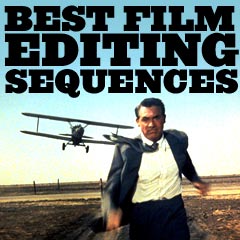
|
Sequences of All-Time: From the Silents to the Present 2000-now |
| Film Title/ Director & Editor and Film Description | ||||||||||||||

|
Crouching Tiger, Hidden Dragon (2000, US/HK/China/Taiwan) (aka Wo Hu Cang Long) d. Ang Lee
Ang Lee combined a tale about a mystical, legendary 400 year-old stolen sword (named Green Destiny), gravity-defying martial arts combat and kinetic action sequences, and star-crossed lovers. It marked the first major American cross-over success of an Asian action film. Lee's martial arts film blended state-of-the-art fighting effects with a 19th century fantasy story of love and bravery. The sword was stolen by the 18 year-old district governor's daughter - the impetuous, willful and headstrong masked thief Jen Yu (Zhang Ziyi) while apprenticing under the harsh tutelage of bitter, heartless and treacherous arch-criminal Jade Fox (Cheng Pei-pei). The film's major set-piece after the theft was the beautifully-graceful, choreographed, stylized, and gravity-defying, blindingly-fast escape of Jen - she scaled up walls, across buildings, down alleyways, and over rooftops to attempt to elude the pursuit of security officer and female warrior Yu Shu Lien (Michelle Yeoh) who wanted to retrieve the stolen sword. They were identified in medium close-ups before the drifting-and-floating pursuit and then once again when the two agile warriors began hand-to-hand fighting on the ground. [Later in the film was another climactic, visually-stunning sword-fight scene set amidst lush green treetops when heroic, Wudan-style martial arts master Li Mu Bai (Chow Yun Fat) battled young fighter Jen on the bending limbs of thin tree branches in a lush bamboo forest.] |
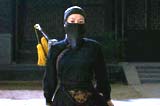  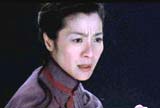 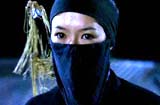 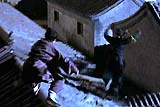 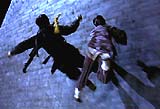
|
||||||||||||

|
Gladiator (2000) d. Ridley Scott
Although this action-filled sword-and-sandals epic was replete with CGI effects and won the Oscar for Best Visual Effects, it was also exceptional for its sharply-edited gladiatorial competitions in the Colosseum for the benefit of the blood-thirsty crowds and Emperor Commodus (Joaquin Phoenix). Heroic Maximus Decimus Meridius (Russell Crowe), known only as the masked, silver-helmeted "Spaniard," led slave trader Proximo's (Oliver Reed) trained gladiators in a mock Battle of Carthage that pitted Barbarians (the losing side) against chariot-drawn archery competitors (the Spaniard urged them to victory: "Whatever comes out of these gates, we've got a better chance of survival if we work together"). Maximus led his group to a decisive victory against the more powerful forces, and then identified himself as Meridius - seeking vengeance against the Emperor for the murder of his family.. He later fought, without his mask, single-handedly in an intense battle in the Colosseum against Rome's only undefeated gladiator - the legendary Tigris of Gaul (Sven-Ole Thorsen). Their vicious swordplay was enhanced by the unleashing of chained tigers (with handlers) that targeted Maximus and lunged at him periodically. Maximus ultimately defeated Tigris and waited for a thumbs-up or thumbs-down signal whether to kill or spare his opponent. When given a thumbs-down, he refused to obey Commodus' command to strike the death blow to his downed and bloodied competitor. It was an insult to the Emperor, but a crowd-pleaser, and he earned the name "Maximus the Merciful." |
     
|
||||||||||||
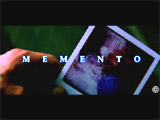
|
Memento (2000) d. Christopher Nolan
This unique, neo-noirish, thought-provoking, and originally-told puzzling who-dun-it thriller was challenging and confusing in itself just to watch due to its non-linear, backwards narrative structure. An earlier film with the same technique of reversed events was Harold Pinter's Betrayal (1983). The themes of this very disorienting and gimmicky film were manipulation of a person's impaired memory and self-deception, grief, repression, guilt and vengeance. The gimmick was intended to convey the memory-confusion of the main protagonist, and pass on some of his disorientation to the film viewing audience. A crucial fact about the smoothly-edited film was that all the black and white inserted scenes in the film played in correct chronological order, while the 22 fragmented color scenes (each about five minutes in length) played in reverse order (although they were chronological within the segment itself). The color scenes were the main narrative of the story. The B/W scenes had all taken place before any of the events shown in the color segments. There were also additional flashbacks within some of the color and B/W segments. Both narratives played separately and alternately until the film's climactic conclusion when the two strands merged into a color sequence - at the time of the strangulation of Jimmy Grantz. The twisty film included mainstays of film noirs - an unreliable narrator, a man in a dark, cruel and untrustworthy world, and a quest to find the truth. In the main plot, the protagonist was suffering from a chronic disorder known as anterograde amnesia (aka Korsokoff's syndrome with an inability to form new memories - i.e., short-term memory loss); he was investigating the brutal and cold-blooded rape and murder of his wife during a late-night burglary; (the main character suffered temporary amnesia during the attack due to a blow to his skull); he proceeded to use his own self-inflicted tattoos, professional tattoos, Polaroids, and cryptic notes to aid his short-term memory and provide clues to finding a second intruder who got away.
Things were further complicated by the fact that the memory-impaired protagonist was being provided with faulty information from two unreliable and manipulative characters who deliberately lied to him, knowing that he would soon forget what they told him. In two separate plot strands, the two deceitful characters had persuaded the protagonist to believe that their murder targets (Dodd and Jimmy Grantz (or John G)) were deserving because they were identified as his wife's killer. Also, the plot element about the incident involving the main character's wife was called into question - was she actually raped and killed, or was she just raped, and then died due to overdoses of insulin? In the film's first scene (although it was located chronologically at the end of the story due to its reversed order), ex-insurance fraud investigator Leonard Shelby (Guy Pearce) had just apparently killed his confidante/associate: "Teddy" Gammell (Joe Pantoliano), a crooked SF undercover cop whose real name was John Edward Gammel (John G); whether Leonard was right or not, he believed that Teddy was one of the murderous burglars and perpetrators of a hideous crime - the rape and murder of his wife. And as the film unfolded, it was revealed that Leonard had, ironically, remembered only some elements about his wife's allegedly traumatic rape-death, but only as a projection onto an accident insurance client named Sammy Jankis (Stephen Tobolowsky) that he was investigating. Teddy was clearly knowledgeable that Sammy's story, in parallel fashion, was actually Leonard's story; Leonard had projected his own life, and his accidental killing of his own wife, onto Sammy (a fictional character); Sammy Jankis' story was actually Leonard Shelby's story; Sammy NEVER really existed as remembered by Leonard. Leonard told a revealing but semi-confused story (intermixed with facts about his own life) about Sammy (whose name was tattooed in cursive writing on his left hand as "Remember Sammy Jankis"), believing that Sammy had faked suffering from memory loss. This led to suspicions that Leonard in parallel fashion had killed his own wife, when she expired from a diabetic coma (not the rape!) when he forgetfully kept providing her with an insulin overdose when she was testing his memory. However, Leonard denied that his wife was diabetic ("My wife wasn't diabetic") - because if she had been, then it would have opened up the possibility that he had killed her with extra doses of insulin. Teddy was quoted as saying: "Maybe you should start investigating yourself." The big reveal at the end was the realization that according to Teddy, Leonard felt he needed the hunt to give himself purpose in life. And then, in his confusion, Leonard turned his sights on Teddy - to convince himself that Teddy was the guilty rapist ("DON'T BELIEVE HIS LIES" was written on Teddy's Polaroid). This was because Teddy actually knew the 'truth' about Leonard and the real cause of his wife's death -- things which Leonard did not want to face, while Teddy was attempting to convince Leonard to end his vengeful hunt, since he had killed his wife's rapist, John G, a year earlier. |
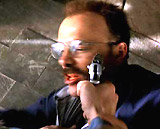 Running in Reverse - The Opening Sequence (Chronologically the End Sequence) - The Murder of Undercover Cop Teddy by Leonard  Tormented Protagonist Leonard 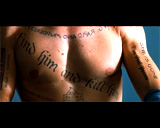 Leonard's Tattooed Body With Clues 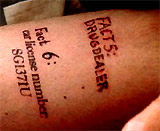 Fact 5 and Fact 6  Fact 3: First Name John (or James) 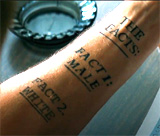 Fact 1 and 2: Male, White 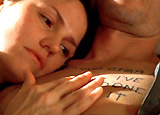 With His Eyes Closed, Leonard's Wish Fulfillment - He Imagined His 'Dead' Wife - Leonard's Final Voice-Over (Tattoo: "I'VE DONE IT") |
||||||||||||
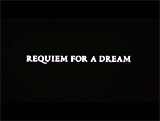
|
Requiem for a Dream (2000) d. Darren Aronofsky This unforgettable anti-drug cautionary tale was composed of many cinematic techniques, including:
Aronofsky employed the repeated quick-cutting of multiple intensely-close-up images in the film whenever one of the principal drug-addicted characters (in this instance, Marion Silver (Jennifer Connelly)) shot up, consumed or snorted drugs:
The unrated (originally rated NC-17) film's tense and final 15 to 20 minutes were assembled together into a powerful montage, to illustrate how lives were utterly shattered and affected by diet pills and stronger drugs. The independent film had about three times the number of edits (2,000) when compared to an average film (600+), especially during the ending when each of the shots were shortened and then presented in an intensely-rapid pace along with a memorable soundtrack. In one of the harrowing ending sequences, elderly Brighton Beach widow Sara Goldfarb (Ellen Burstyn) - addicted to a regimen of amphetamine diet pills - was subjected to intense electro-shock therapy treatment in a mental institution, while her heroin-addicted druggie son Harry Goldfarb (Jared Leto) had his painfully-infected arm amputated (due to repeated intravenous injections) - with blood spurting onto his face from the saw. Meanwhile, his girlfriend Marion Silver prostituted herself in a decadent lesbian orgy to raise money to support her addiction. All of the main characters ended up in a fetal position as the film concluded. |
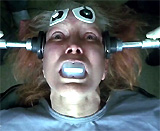 Sara's Electro-shock Therapy 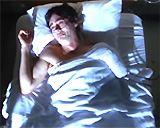 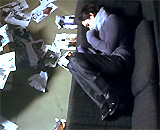 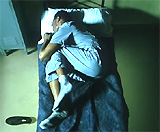 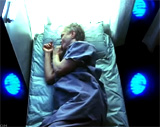 Four Fetal Positions |
||||||||||||
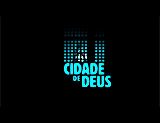
|
City of God (2002, Braz./Fr./US) (aka Cidade de Deus) d. Fernando Meirelles, Katia Lund
Covering a period of two decades (from the 1960s to the 1980s), this auteurist crime-drama film told about the Cidade de Deus, a violent slum-ghetto section of housing projects in Rio de Janiero. There, a young fishmonger's son grew up amidst gang warfare and drug-dealing. The all-digital film was rich with experimental techniques, including:
It opened with a crisply-edited, full-of-energy, electrifying credits sequence, underscored with frenetic music and violence typically found in the underbelly of Rio. Chickens were being prepared by a gang for a picnic meal of shish-kabobs. The birds were de-feathered and cleaned with long sharpened machetes, but one live chicken escaped and was chased through the streets (and even shot at) by the gang. The group ran into the main protagonist or narrator, an aspiring photo-journalist named Rocket/Buscape (Alexandre Rodrigues) who introduced the story with a flashback to ten years earlier (signified by a shift to sepia-tone), after he found himself, in a whirling, circling shot (a bullet-time type wipe shot), between the gang members and the cops. |
 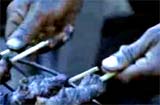 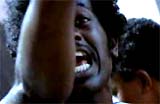 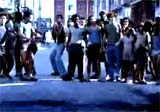 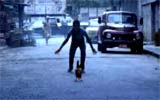 
|
||||||||||||
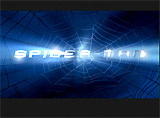
|
d. Sam Raimi Geeky, bespectacled Midtown HS senior Peter Parker (Tobey Maguire) had recently been bitten by a "genetically-designed super-spider" during a school field trip to Columbia University's Science Department - and was soon transformed. In the CGI-enhanced Costume Montage sequence, he brainstormed - and designed a crude 'Human Spider' costume for himself in preparation for entering an amateur wrestling competition to win $3,000 in order to buy a car to impress his next-door neighbor classmate Mary Jane Watson (Kirsten Dunst). Prototype sketches of a costume and its 'spider' symbol were made and displayed through a series of overlapping, superimposed images. Reportedly there were over 40 live-action and graphic elements combined in the approximately one-minute segment. |
  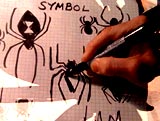 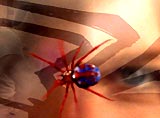 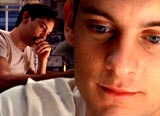 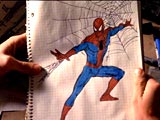
|
||||||||||||

|
xXx (2002) (aka Triple X) d. Rob Cohen Director Rob Cohen's PG-13-rated action film, with a very cliched and thin James Bondian-styled plot, had a booming soundtrack and well-choreographed stunts, including:
It starred Vin Diesel as unemployed, anti-authority, cyber-savvy bad-ass and extreme-sports daredevil named Xander Cage. In the film's spectacular scene of a death-defying, flying motorcycle stunt (filmed with nine cameras from different angles to produce a "cubist editing" approach), the rule-breaking, muscle-bound, leather-clad and tattooed Xander took a five-second bike jump over an exploding barn in the Colombian drug farm scene, between two strands of razor wire atop a 30-foot fence while military helicopters were engaged in machine-gun fire above him. The jump's duration was extended to about 30 seconds, through film editing. The action cut away, then showed various angles of the same jump (from behind, the side, from above and from below) -- to heighten the adrenaline-rushing experience. |
  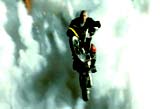 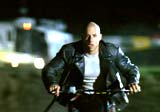 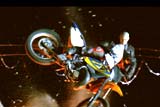
|
||||||||||||